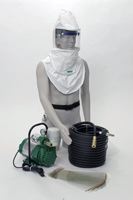 |
 |
| MSDS Topics |
Free Sites | FAQ's | Regulations | Glossary | Software | Suppliers |
| Books | Forum | Poll | Fun stuff | Quiz | Store | |
| MSDS and safety supplies | Search ALL our MSDS info | |||||
 | |||
 |
 |
 |
|
| Title: 06/13/1990 - Ventilation for an anhydrous ammonia refrigeration system. | |
| Record Type: Interpretation | Standard Number: 1910.134, 1910.307(b), 1910.1000, 1910.1200(g) |
June 13, 1990
MEMORANDUM FOR: LINDA R. ANKU
REGIONAL ADMINISTRATOR
FROM: PATRICIA K. CLARK
DIRECTOR DESIGNATE
DIRECTORATE Of COMPLIANCE PROGRAMS
SUBJECT: Dilution Ventilation and Intrinsic Safety
in the Mechanical Control Room for an
Anhydrous Ammonia Refrigeration System
This is in response to your memorandum of April 9, regarding the above subject. As you know, the applicable industry consensus standards for refrigeration systems, including the system that uses ammonia as a refrigerant, are contained in ANSI/ASHRAE 15-1989. Section 10.14(j) of the ANSI/ASHRAE standard, however, precludes the ammonia refrigeration system control room from being classified as a Class I, Division 2 location, if the provisions contained in Sections 10.14(h) and 10.14(i) of the same standard are met.The company at time of the inspection had not installed a ventilation system meeting the specifications of the ANSI/ASHRAE standard and, consequently, was in apparent violation of 1910.307(b), for exposing employees to explosion hazards. We advise that a 1910.307(b) citation be issued.
Because the company, [company name withheld], is proposing to install a ventilating system to meet the design requirements specified in the ANSI/ASHRAE standard, the company, will have abated 1910.307(b) violation when the system is installed. They would then not be required to install blower fans that are intrinsically safe.
|
It should be noted that the installation of a vapor detector system as described in your memorandum may potentially eliminate the explosion hazard but would not eliminate the inhalation hazards likely to cause death or serious physical harm. The health hazards associated with ammonia are recognized by ANSI, as referenced in Table 2 of ANSI K61.1 - 1989 (copy attached), and a release of ammonia to contaminate the control room area in concentrations greater than 2,500 ppm in air, could be fatal if the necessary precautions are not taken. Though the referenced ANSI standard is not applicable to the situation you described, the inhalation hazard is recognized and must also be addressed by the company. In order to protect against both safety and health hazards, the vapor detector system to be installed shall be capable of providing an audible alarm at an ammonia vapor concentration of 2,500 ppm in the air in the control room, and shall be capable of activating the exhaust blowers when the ammonia vapor concentration in the air in the control room reaches 40,000 ppm. Employees who may have to enter the control room during emergencies shall be fully equipped with the appropriate personal protective equipment, and shall be trained to meet OSHA standards at 1910.120, 1910.134, and 1910.1200. |  Protect your workers with supplied air respirator systems like this one from Safety Emporium. |
The official, public domain, OSHA version of this document is available at http://www.osha.gov/pls/oshaweb/owadisp.show_document?p_table=INTERPRETATIONS&p_id=20014&p_text_version=FALSE